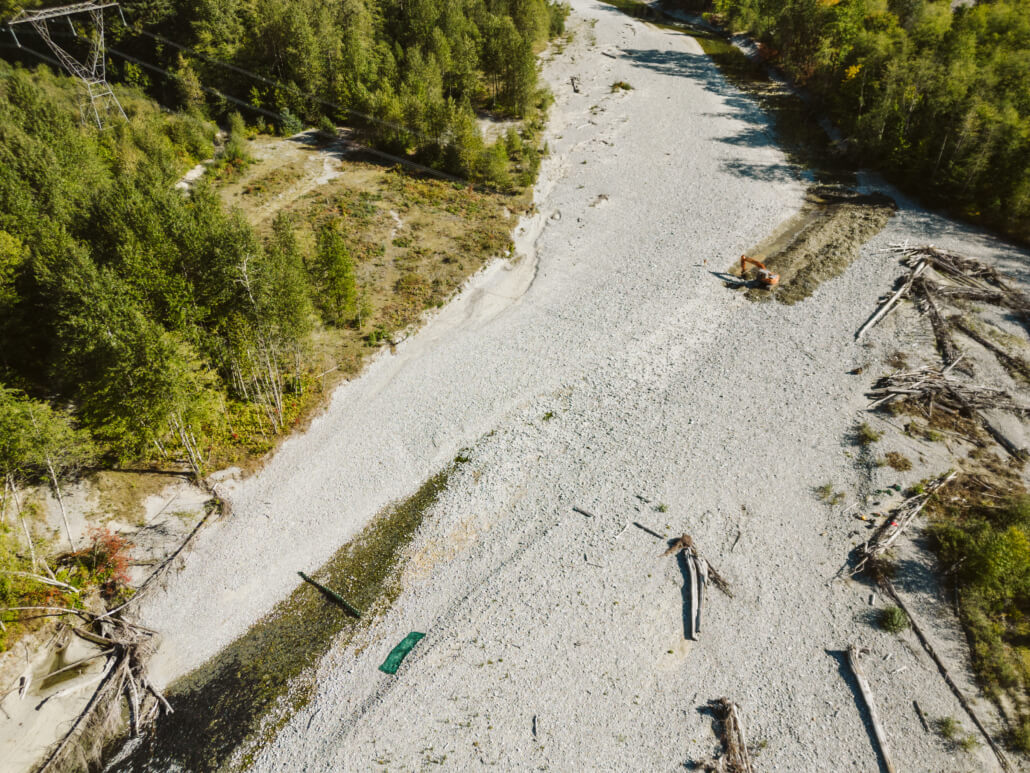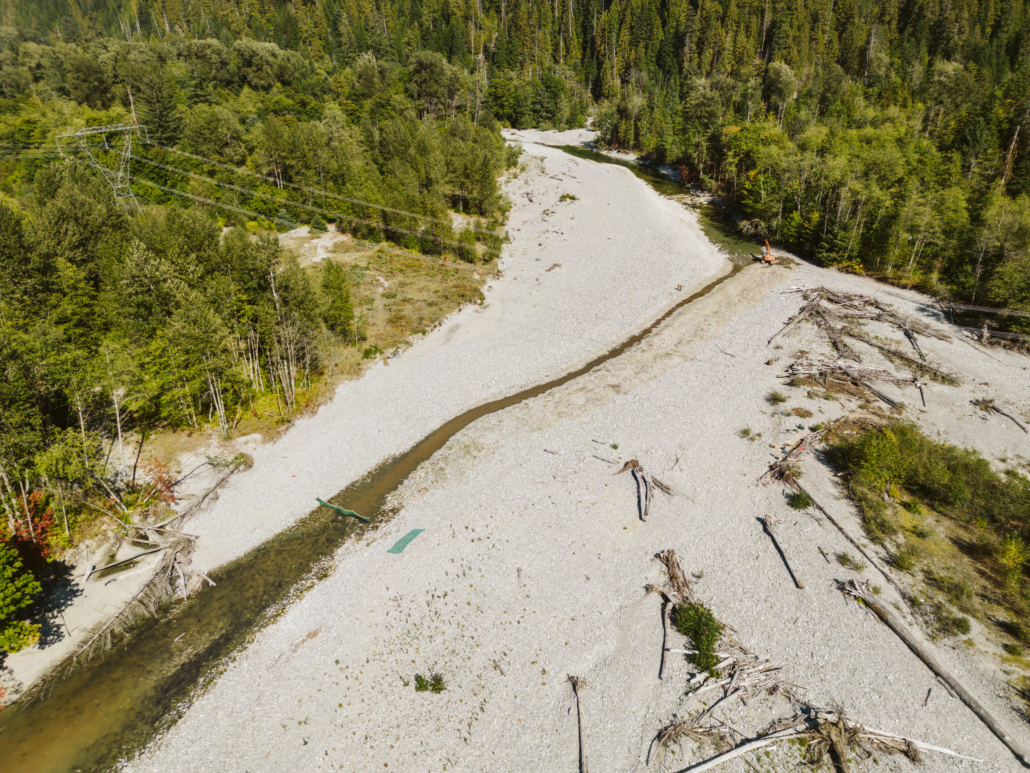Extreme climate events like drought and flood can wreak havoc on salmon migrations. PSF worked with partners across B.C. this summer and fall during an unprecedented, province-wide drought to improve fish passage in rivers like xʔəl̓ilwətaʔɬ where salmon were stranded.
This story originally appeared in the Winter 2023 edition of Salmon Steward, the Pacific Salmon Foundation’s quarterly print magazine.
In early September, tens of thousands of returning pink salmon were stranded by a 300-metre-long section of xʔəl̓ilwətaʔɬ (Indian River) that went dry during extreme drought.
Severe drought conditions gripped watersheds across British Columbia this summer and fall, causing warm water temperatures, low oxygen levels, and low flows — conditions that can be devastating for salmon.
Pink salmon were returning to xʔəl̓ilwətaʔɬ in strong numbers but encountered low river flows approximately six kilometres north of the river’s estuary. The parched area interrupted their migration to their spawning grounds, delaying their journey and threatening their survival.
“There were too many fish for how little water there was,” says Graham Nicholas, senior environmental specialist with səlilwətaɬ (Tsleil-Waututh Nation). “They pooled up into the deeper spots that were available, but soon used up all the oxygen. They started to die off pre-spawn.”
With zero rain in the imminent forecast, this migration bottleneck had potential to become a mass fish die-off.
So səlilwətaɬ and Fisheries and Oceans Canada (DFO) struck a plan to help the stranded pink salmon move upstream and prepare for the returning chum salmon, expected a few weeks later. With support from PSF’s rapid response drought team, crews quickly repaired the barrier within days by digging a trench through the disconnected gravel strip with an excavator, restoring river flows.


More than 18,000 stranded pink salmon adults successfully migrated upstream as a result of the restoration effort.
“We were not going to sit back and watch a full-scale climate disaster unfold. This work needed to be done in order to save tens of thousands of salmon,” says Nicholas.
“DFO’s Habitat Restoration Centre of Expertise engineers and biologists collaborated with səlilwətaɬ technicians and biologists to excavate a channel to reconnect flows through the dry riverbed,” says Rebecca Seifert, a DFO restoration biologist. “With crucial support from PSF, our collective efforts resulted in the successful construction of a channel that was deep enough to facilitate salmon passage to spawning habitats upstream. This work also increased the flow of fresh, cold water downstream to pools where oxygen levels were getting dangerously low while the pink salmon were holding.”
In 2023, for the second consecutive year, sections of xʔəl̓ilwətaʔɬ dried out. With nearly half a million salmon in the river when it ran dry this year, the recurrence of climate extremes is becoming a source of growing concern.
The xʔəl̓ilwətaʔɬ watershed is a cornerstone of səlilwətaɬ heritage, intertwined with their history, culture, and economy. səlilwətaɬ continues to diligently protect this ecosystem, preserving its significance for future generations.
“The xʔəl̓ilwətaʔɬ watershed has suffered major devastation over time. səlilwətaɬ has taken our own initiatives to restore the lands and waterways, to ensure future uses,” says Michelle George, cultural technical specialist with səlilwətaɬ Treaty, Lands and Resources. “səlilwətaɬ understands the interconnection between the lands and waters, making it that much more vital to carry on traditional and cultural practices throughout the homelands of səlilwətaɬ. I have fished the xʔəl̓ilwətaʔɬ waters and would like to see future generations have the opportunity to do the same.”
To better understand xʔəl̓ilwətaʔɬ watershed dynamics, səlilwətaɬ and DFO are gathering Light Detection and Ranging (LiDAR) data. This information will inform restoration plans, particularly for low flow river issues during the summer.
What is LiDAR?
LiDAR, or Light Detection and Ranging, measures distances to the Earth’s surface with pulsed lasers. This technology provides detailed three-dimensional information on our planet’s shape and surface features. For salmon research, LiDAR can provide detailed maps of streams and watersheds.
With funding from PSF, an external contractor conducted an aerial survey to collect LiDAR data in October from the xʔəl̓ilwətaʔɬ estuary to the Meslilloet Creek Confluence.
DFO funding will support the data processing. LiDAR information will enable experts to map the river’s contours, identify areas prone to erosion, pinpoint obstacles blocking natural flows, and assess the health of riverbanks. It will also provide information on barriers that hinder salmon migration and habitat zones critical for salmon spawning and rearing.
Ultimately, access to LiDAR data will support the development of more effective restoration activities to revitalize the xʔəl̓ilwətaʔɬ watershed.
Since July, PSF has approved $330,000 in funding for more than a dozen urgent drought response projects to help combat the adverse impacts of climate change on salmon. These important projects emerged through a rapid response working group with DFO, the Province, and technical experts that PSF convened in the spring with the aim to plan ahead for anticipated drought-related issues.
Special thank you to the Province of B.C. for its support in kickstarting rapid drought response for salmon.


